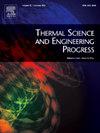厌氧消化物转化为生物能源的可持续管理:质量和能量平衡、性能指标、热热解行为
IF 5.1
3区 工程技术
Q2 ENERGY & FUELS
引用次数: 0
摘要
本文研究了原料消化液(RD)的焙烧以提高产品的性能,然后对RD和焙烧产物的热热解行为进行了分析。结果表明:焙烧反应温度对焙烧反应的主要指标有质量产率(MY%)、能产率(EY%)、高热值(HHV)、能质协同效益指数(EMCI)等影响。当温度升高200°C至300°C时,MY%从~ 95%下降到~ 69%,而EY%最初升高到260°C,然后保持不变直到300°C。温度从200℃升高到300℃,与RD相比,焙烧使固定碳和HHV分别提高14.3 ~ 86.7%和15.8 ~ 35.8%,但灰分含量增加。将RD在240°C下焙烧30分钟,在固定碳和灰分含量之间进行权衡的情况下,在MY%、EY%和HHV方面获得了最佳结果。此外,通过无模型和基于模型的动力学模型研究了RD和TD240的热热解行为,以研究热分解下的动力学初级反应。采用Friedman、Kissinger-Akahira-Sunose (KAS)和Ozawa-Flynn-Wall (OFW)模型估算的TD240的活化能(Ea)分别从RD的129.2 ~ 225.9 kJ/mol、122.4 ~ 203.5 kJ/mol和127.3 ~ 227.4 kJ/mol降至107.5 ~ 132.4 kJ/mol、110.4 ~ 132.8 kJ/mol和106.2 ~ 132.7 kJ/mol。RD和TD240的活化焓(ΔH)分别为123.9 ~ 190 kJ/mol和108.4 ~ 127.6 kJ/mol。此外,质量和能量平衡表明,该工艺在不需要任何外部能量的情况下自效率为97.65%。总体而言,焙烧工艺对现有沼气厂的改造效果显著。本文章由计算机程序翻译,如有差异,请以英文原文为准。
Sustainable management of anaerobic digestate through torrefaction into bioenergy: Mass and energy balance, performance indices, thermal-pyrolysis behavior
This study examines the torrefaction of raw digestate (RD) to upgrade properties of product followed by thermal-pyrolysis behaviour analysis of RD and torrefied product. Results showed that key torrefaction indices mainly mass yield (MY%), energy yield (EY%), higher heating ealue (HHV), energy-mass co-benefit index (EMCI) were affected by torrefaction reaction temperature. As temperature increased 200 °C to 300 °C, MY% was decreased from∼95 % to ∼69 % while EY% initially enhanced till 260 °C, then became constant till 300 °C. Torrefaction enhanced fixed carbon and HHV by 14.3–86.7 % and 15.8–35.8 % as compared to RD as temperature increased from 200 to 300 °C, however, ash content increased. Torrefaction of RD at 240 °C for 30 mins provided best results in terms of MY%, EY% and HHV with tradeoff between fixed-carbon and ash-content. Furthermore, thermal-pyrolysis behaviour of RD and TD240 was investigated by model-free and model-based kinetic models to examine the kinetics primary reactions under thermal decomposition. Estimated activation energies (Ea) reduced from 129.2-225.9 kJ/mol, 122.4–203.5 kJ/mol, and 127.3–227.4 kJ/mol for RD to 107.5–132.4 kJ/mol, 110.4–132.8 kJ/mol and 106.2–132.7 kJ/mol for TD240 using Friedman, Kissinger-Akahira-Sunose (KAS) and Ozawa-Flynn-Wall (OFW) models respectively. Activation enthalpy (ΔH) obtained 123.9–190 kJ/mol and 108.4–127.6 kJ/mol for RD and TD240. Furthermore, mass and energy balance showed the process has 97.65 % self-efficient without any external energy. Overall, effectiveness of torrefaction process showed to upgrade the existing biogas plants.
求助全文
通过发布文献求助,成功后即可免费获取论文全文。
去求助
来源期刊

Thermal Science and Engineering Progress
Chemical Engineering-Fluid Flow and Transfer Processes
CiteScore
7.20
自引率
10.40%
发文量
327
审稿时长
41 days
期刊介绍:
Thermal Science and Engineering Progress (TSEP) publishes original, high-quality research articles that span activities ranging from fundamental scientific research and discussion of the more controversial thermodynamic theories, to developments in thermal engineering that are in many instances examples of the way scientists and engineers are addressing the challenges facing a growing population – smart cities and global warming – maximising thermodynamic efficiencies and minimising all heat losses. It is intended that these will be of current relevance and interest to industry, academia and other practitioners. It is evident that many specialised journals in thermal and, to some extent, in fluid disciplines tend to focus on topics that can be classified as fundamental in nature, or are ‘applied’ and near-market. Thermal Science and Engineering Progress will bridge the gap between these two areas, allowing authors to make an easy choice, should they or a journal editor feel that their papers are ‘out of scope’ when considering other journals. The range of topics covered by Thermal Science and Engineering Progress addresses the rapid rate of development being made in thermal transfer processes as they affect traditional fields, and important growth in the topical research areas of aerospace, thermal biological and medical systems, electronics and nano-technologies, renewable energy systems, food production (including agriculture), and the need to minimise man-made thermal impacts on climate change. Review articles on appropriate topics for TSEP are encouraged, although until TSEP is fully established, these will be limited in number. Before submitting such articles, please contact one of the Editors, or a member of the Editorial Advisory Board with an outline of your proposal and your expertise in the area of your review.
 求助内容:
求助内容: 应助结果提醒方式:
应助结果提醒方式:


